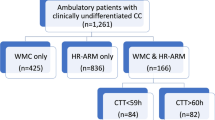Abstract
Purpose
This study evaluates colon transit time (CTT) and anorectal manometry (ARM) in spina bifida (SB) patients in relation to the level of lesion, mobility, constipation, and continence status.
Methods
SB patients between 6 and 19 years, who are not using antegrade continence enemas and followed at the SB Reference Centre UZ Ghent, were asked to participate. Medical history was retrospectively retrieved from the medical file. Stool habits were prospectively collected using standardized questionnaires. CTT was measured using the 6-day pellet abdominal X-ray method. ARM was performed in non-sedated children with a water-perfused, latex-free catheter.
Results
Forty out of 52 eligible patients consented to perform CTT, of which 19 also performed the ARM. Fifteen (37 %) SB patients were constipated despite treatment. Twenty-six (65 %) were (pseudo) continent. The total CTT was significantly prolonged in SB patients (median CTT 86.4 vs. 36 h controls). The CTT was significantly prolonged in constipated SB patients compared to non-constipated SB patients (122.4 vs. 52.8 h). Spontaneously continent patients had a normal CTT (33.6 h) as well as a significantly higher resting pressure compared to the pseudo-continent and incontinent SB patients (resting pressure 56.5 vs. 32.5 mmHg). An abnormal CTT was associated with a treatment necessity to achieve pseudo-continence (p = 0.006).
Conclusion
CTT in SB patients was significantly prolonged, indicating a neurogenic involvement of the bowel and slow transit constipation. SB patients with a normal CTT and a normal ARM spontaneously achieved fecal continence. CTT can help tailor the continence therapy in SB patients.



Similar content being viewed by others
References
Verhoef M, Lurvink M, Barf HA, Post MW, Van Asbeck FW, Gooskens RH et al (2005) High prevalence of incontinence among young adults with spina bifida: description, prediction and problem perception. Spinal Cord 43(6):331–340
Malone P, Wheeler R, Williams J (1994) Continence in patients with spina bifida: long term results. Arch Dis Child 70:107–110
Vande Velde S, Van Biervliet S, Van Renterghem K, Van Laecke E, Hoebeke P, Van Winckel M (2007) Achieving fecal continence in patients with spina bifida: a descriptive cohort study. J Urol 178(6):2640–2644, discussion 4
Krogh K, Lie HR, Bilenberg N, Laurberg S (2003) Bowel function in Danish children with myelomeningocele. APMIS 109:S81–S85
Pigeon N, Leroi AM, Devroede G, Watier A, Denis P, Weber J, Arhan P (1997) Colonic transit time in patients with myelomeningocele. Neurogastroenterol Motil 9(2):63–70
Bouchoucha M, Devroede G, Faye A, Arsac M (2002) Importance of colonic transit evaluation in the management of fecal incontinence. Int J Colorectal Dis 17(6):412–417, discussion 8-9
Lin HC, Prather C, Fisher RS et al (2005) Measurement of gastrointestinal transit. Dig Dis Sci 50(6):989–1004
Southwell BR, Clarke MCC, Sutcliffe J, Hutson JM (2009) Colonic transit studies: normal values for adults and children with comparison of radiological and scintigraphic methods. Pediatr Surg Int 25:559–572
Arhan P, Faverdin C, Devroede G, Pierre-Kahn A, Scott H, Pellerin D (1984) Anorectal motility after surgery for spina bifida. Dis Colon Rectum 27(3):159–163
Marte A, Cotrufo AM, Di Iorio G, De Pasquale M (2001) Electromyographic and manometric anorectal evaluation in children affected by neuropathic bladder secondary to myelomeningocele. Minerva Pediatr 53(3):171–176
Lewis SJ, Heaton KW (1997) Stool form as a useful guide to intestinal transit time. Scand J Gastroenterol 32:920–924
Longstreth GF, Thompson WG, Chey WD et al (2006) Functional bowel disorders. Gastroenterology 130(5):1480–1491
Vaizey CJ, Carapeti E, Cahill JA, Kamm MA (1999) Prospective comparison of faecal incontinence grading systems. Gut 44:77–80
Kumar S, Ramadan S, Gupta V, Helmy S, Atta I, Alkholy A (2009) Manometric tests of anorectal function in 90 healthy children: a clinical study from Kuwait. J Ped Surg 44:1786–1790
Abrahamsson H, Antov S, Bosaeus I (1988) Gastrointestinal and colonic segmental transit time evaluated by a single abdominal x-ray in healthy subjects and constipated patients. Scand J Gastroenterol 23:S72–S80
Arhan P, Devroede G, Jehannin B et al (1981) Segmental colonic transit time. Dis Colon Rectum 24:625–629
Di Lorenzo C, Benninga MA (2004) Pathophysiology of pediatric fecal incontinence. Gastroenterology 126(1 Suppl 1):S33–S40
Bouchoucha M, Devroede G, Arhan P et al (1992) What is the meaning of colorectal transit time measurement? Dis Colon Rectum 35:773–782
Conflict of interest
The authors declare no conflicts of interest.
Author information
Authors and Affiliations
Corresponding author
Rights and permissions
About this article
Cite this article
Velde, S.V., Pratte, L., Verhelst, H. et al. Colon transit time and anorectal manometry in children and young adults with spina bifida. Int J Colorectal Dis 28, 1547–1553 (2013). https://doi.org/10.1007/s00384-013-1733-6
Accepted:
Published:
Issue Date:
DOI: https://doi.org/10.1007/s00384-013-1733-6




